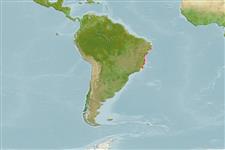Classification / Names
Nomi Comuni | Sinonimi | Catalog of Fishes(Genere, Specie) | ITIS | CoL | WoRMS | Cloffa
>
Blenniiformes (Blennies) >
Labrisomidae (Labrisomids)
Etymology: Paraclinus: Greek, para = the side of + Greek, klinein, kline = sloping and bed, due to the four apophyses of sphenoid bone (Ref. 45335); arcanus: Named for its habit of hiding underneath rocks (secretive).
Environment: milieu / climate zone / depth range / distribution range
Ecologia
marino associati a barriera corallina; distribuzione batimetrica 0 - 3 m (Ref. 43114). Tropical; 5°S - 23°S
Distribuzione
Stati | Aree FAO | Ecosystems | Presenze | Point map | Introduzioni | Faunafri
Southwest Atlantic: Brazil.
Size / Peso / Age
Maturity: Lm ? range ? - ? cm
Max length : 3.2 cm SL maschio/sesso non determinato; (Ref. 43114)
Spine dorsali (totale) : 30 - 32; Spine anali: 2; Raggi anali molli: 18 - 20; Vertebre: 36. Higher number of dorsal fin spines. Has a short nuchal cirrus with 2-4 small projections, cirrus never in the shape of a rounded lappet (rounded with short points on its margin in P. fasciatus). Has a wide scaleless area along the anterior portion of dorsal fin base (narrow area in P. fasciatus). Scales present on pectoral fin base (absent in P. cingulatus) (Ref. 43114).
Inhabit shallow reef habitats. Smallest ripe female 2.25 cm SL (Ref. 43114).
Life cycle and mating behavior
Maturità | Riproduzione | Deposizione | Uova | Fecundity | Larve
Guimarães, R.Z.P. and A.C.L.H. de Bacellar, 2002. Review of the Brazilian species of Paraclinus (Teleostei: Labrisomidae), with descriptions of two new species and revalidation of Paraclinus rubicundus (Starks). Copeia 2002(2):419-427. (Ref. 43114)
IUCN Red List Status (Ref. 130435: Version 2024-2)
Threat to humans
Harmless
Human uses
Strumenti
Special reports
Download XML
Fonti Internet
Estimates based on models
Phylogenetic diversity index (Ref.
82804): PD
50 = 0.5000 [Uniqueness, from 0.5 = low to 2.0 = high].
Bayesian length-weight: a=0.00537 (0.00222 - 0.01301), b=3.08 (2.87 - 3.29), in cm total length, based on LWR estimates for this (Sub)family-body shape (Ref.
93245).
Trophic level (Ref.
69278): 3.3 ±0.4 se; based on size and trophs of closest relatives
Fishing Vulnerability (Ref.
59153): Low vulnerability (10 of 100).
